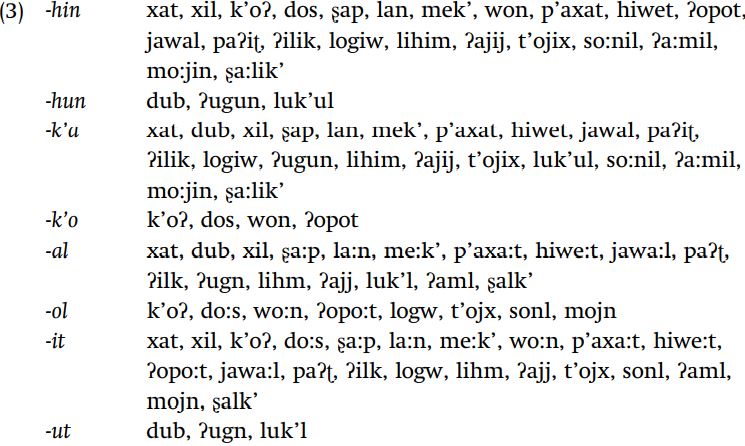

Grammar


Tenses


Present

Present Simple

Present Continuous

Present Perfect

Present Perfect Continuous


Past

Past Simple

Past Continuous

Past Perfect

Past Perfect Continuous


Future

Future Simple

Future Continuous

Future Perfect

Future Perfect Continuous


Parts Of Speech


Nouns

Countable and uncountable nouns

Verbal nouns

Singular and Plural nouns

Proper nouns

Nouns gender

Nouns definition

Concrete nouns

Abstract nouns

Common nouns

Collective nouns

Definition Of Nouns

Animate and Inanimate nouns

Nouns


Verbs

Stative and dynamic verbs

Finite and nonfinite verbs

To be verbs

Transitive and intransitive verbs

Auxiliary verbs

Modal verbs

Regular and irregular verbs

Action verbs

Verbs


Adverbs

Relative adverbs

Interrogative adverbs

Adverbs of time

Adverbs of place

Adverbs of reason

Adverbs of quantity

Adverbs of manner

Adverbs of frequency

Adverbs of affirmation

Adverbs


Adjectives

Quantitative adjective

Proper adjective

Possessive adjective

Numeral adjective

Interrogative adjective

Distributive adjective

Descriptive adjective

Demonstrative adjective


Pronouns

Subject pronoun

Relative pronoun

Reflexive pronoun

Reciprocal pronoun

Possessive pronoun

Personal pronoun

Interrogative pronoun

Indefinite pronoun

Emphatic pronoun

Distributive pronoun

Demonstrative pronoun

Pronouns


Pre Position


Preposition by function

Time preposition

Reason preposition

Possession preposition

Place preposition

Phrases preposition

Origin preposition

Measure preposition

Direction preposition

Contrast preposition

Agent preposition


Preposition by construction

Simple preposition

Phrase preposition

Double preposition

Compound preposition

prepositions


Conjunctions

Subordinating conjunction

Correlative conjunction

Coordinating conjunction

Conjunctive adverbs

conjunctions


Interjections

Express calling interjection

Phrases

Sentences


Grammar Rules

Passive and Active

Preference

Requests and offers

wishes

Be used to

Some and any

Could have done

Describing people

Giving advices

Possession

Comparative and superlative

Giving Reason

Making Suggestions

Apologizing

Forming questions

Since and for

Directions

Obligation

Adverbials

invitation

Articles

Imaginary condition

Zero conditional

First conditional

Second conditional

Third conditional

Reported speech

Demonstratives

Determiners


Linguistics

Phonetics

Phonology

Linguistics fields

Syntax

Morphology

Semantics

pragmatics

History

Writing

Grammar

Phonetics and Phonology

Semiotics


Reading Comprehension

Elementary

Intermediate

Advanced


Teaching Methods

Teaching Strategies

Assessment
The first step: morphology
المؤلف:
David Odden
المصدر:
Introducing Phonology
الجزء والصفحة:
149-6
31-3-2022
1575
The first step: morphology
First we need a morphological analysis of the data. In a simple case, this involves looking at columns and rows of data, and figuring out which subparts of words are consistently present with one meaning, and which other subparts are consistently present with other meanings. This task is more complicated when the surface shape of roots and affixes changes due to phonological rules. We cannot provide a definitive morphological analysis of these data without knowing what the phonological system is, and certainty as to the phonological rules is impossible without knowing the morphological analysis. We break out of this seeming circle by adopting – and constantly revising in the face of new evidence – a preliminary and less precise analysis of the phonology and morphology. Improvement in the underlying representations should result in better rules, and as we refine the system of rules, the nature of the underlying distinctions becomes clearer.
In this case, four suffixes are added to roots, -hin ~ -hun ‘nonfuture,’ -k’a ~ -k’o ‘imperative,’ -al ~ -ol ‘dubitative’, and -it ~ -ut ‘passive aorist.’ The notation -hin ~ -hun indicates that the suffix is pronounced either as -hin or as -hun. We need to discover when one form versus the other is used, and express that relation in terms of an underlying form and a rule changing the underlying form.
Stem variants. Some stems have only one surface shape: xat- ‘eat,’ dub- ‘lead by hand,’ xil- ‘tangle,’ and k’oʔ- ‘throw,’ so the most natural assumption would be that these are the underlying forms for these particular stems (this assumption may turn out to be wrong, but it is a good starting assumption). Most stems in the data set have two surface manifestations. An important first step in understanding the rules of the language is to identify the alternations in the data, and one way to make the alternations explicit is to list the phonetic variants of each stem.


In these cases, decisions must be made regarding the underlying forms.
Suffix variants. We must decide what the underlying form of each suffix is, and they all have two surface variants in terms of their vowel: either a nonrounded vowel or a rounded vowel. For each suffix, we group the verbs in terms of which variant of the suffix is used with them.

 الاكثر قراءة في Morphology
الاكثر قراءة في Morphology
 اخر الاخبار
اخر الاخبار
اخبار العتبة العباسية المقدسة

الآخبار الصحية















 قسم الشؤون الفكرية يصدر كتاباً يوثق تاريخ السدانة في العتبة العباسية المقدسة
قسم الشؤون الفكرية يصدر كتاباً يوثق تاريخ السدانة في العتبة العباسية المقدسة "المهمة".. إصدار قصصي يوثّق القصص الفائزة في مسابقة فتوى الدفاع المقدسة للقصة القصيرة
"المهمة".. إصدار قصصي يوثّق القصص الفائزة في مسابقة فتوى الدفاع المقدسة للقصة القصيرة (نوافذ).. إصدار أدبي يوثق القصص الفائزة في مسابقة الإمام العسكري (عليه السلام)
(نوافذ).. إصدار أدبي يوثق القصص الفائزة في مسابقة الإمام العسكري (عليه السلام)


















